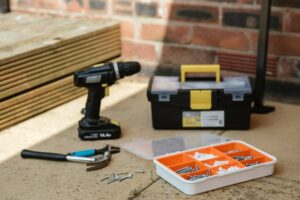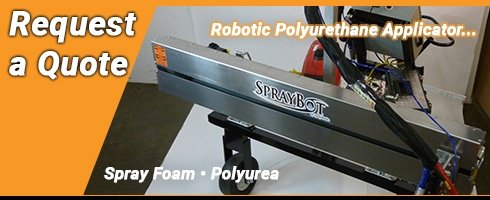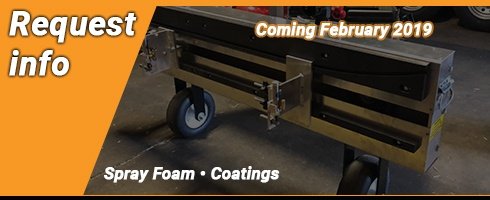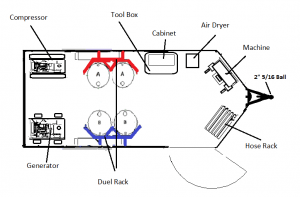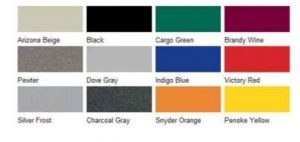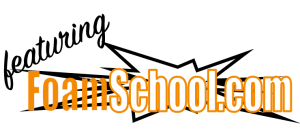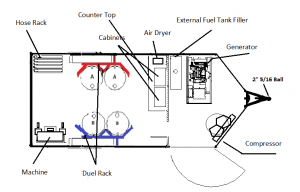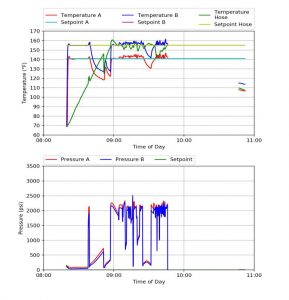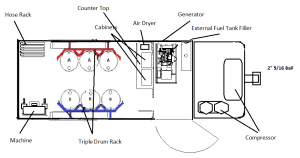Spraybot Tutorial (FULL) – commercial roofing spray foam robot and polyurea applicator
Transcription Details
File type: Video to text
Time: 21:33 minutes
File Name: Spraybot Tutorial
Transcription Results
Okay, so you’ve unpacked your Spraybot and now you have to get familiar with the Spraybot. That’s probably the most important thing right off the bat, though. The quickest way to do that is to take a look inside the toolbox. There’s a lot of supplies in here that have been provided. And as you go through them, you’ll get familiar with the changes you need to make, the modifications with your equipment, and the things that are specific to the Spraybot. Right away, you’ll notice the T connection or the Y it’s the quick disconnect that you need to install at your whip hose and the last 50-foot section or the last section of hose. It just so happens to be that 10-foot whip works best, it places this in the proper position that we need. This is one of the few modifications you’re going to have to do to your equipment. And we’ll go over that later.
This is a replacement air line for the solenoid. This is an extra there’s already one installed. This is for later, you can save it. This is a service bypass for when you’re oiling and servicing the head. This isn’t for normal operation. But this is the bypass. You’ll see some extra knobs here for the gun, the universal gun mount. Again, these are spares. There’s four on the mount already. Inside this bag, you’ll see the quick release pin. This is for your free wheel motion that allows the car to move without the gears turning. This allows you to use it real fast and scoot across the roof just by pushing it without having the motor engaged. This is an extra one again, there’s one already in the drive system, which we’ll go over that again later. There’s a fuse in here. For the electrical panel. There’s three fuses, they’re all the same. So, there’s an extra fuse in there, just in case. And then there’s a spare bolt for your windscreen. And again, that’s extra stuff that you’ll use later. So, you don’t need that. You’ll see a various bags up here on the top of the box. Another bag you’ll notice there’s two screws, carriage bolt style. These again are for your windscreen frame up front. You’ll need those right away so set those closed, not too far away.
All right, next you’ll notice a couple of bolts that you’re going to need for your gun handle. Again, you want to keep these out in close. They have the washer and the lock washer and the bolt on here. You’ll need a 9/16″ wrench for that. You want to get stock in 9/16″ wretches, that’s what most of the bolts on the service side of the Spraybot will use. So, again, keep those close.
Next, we’ll look in what’s underneath the tray. Okay, right away you’ll see the gun handle, the universal gun mount we call it and it’ll be complete already assembled with the air piston on it, you’ll have to make some adjustments to this for your gun and we’ll show you what to do with that in a later video. But right off the bat you’ll notice that it is a complete gun, the two bolts that we discussed are for here and this is for mounting on the actuator or the head and we’ll dig into that later. Right here is the clamps for the rotating hose holder. You’ll notice up on the hose mask, this is something that you’ll install on your whip. And these grooves align with the locking mechanism on the hose rotator and allow everything to line up right. But this allows you to put the hose in the correct position so that you can mount the gun into the holder.
Okay, next you’ll see that there’s a bag of gear oil in here, a bottle of gear oil in a bag. So, the gear oil is what you use to lubricate the chain. Do that periodically not so much that you dripping but it does require some oil from time to time. There’s a set of air hoses in here. These are the air hoses that we use to actuate the air piston that engages your trigger on your gun. There’s two of these in here. You will need one of these right away, the other one is a backup or a spare. These are either installed inside your whip along with the other air hose and stuff and then just tucked away when you’re not using it, or a lot of people just install it externally, once we install the airline, we’ll show you that later on. Again, keep one of those out.
Right here is the lift kit. This is a chassis lift kit. Once you put it on, they generally leave it on but this gets installed on the front wheels. There’s two blocks inside here and the bolts to extend the chassis height. This will allow the windscreen to ride above the ribs while doing a slow metal roofing. If you’re not doing that, you won’t need them. But that’s what these are.
First thing you’re going to want to do is get familiar with the universal gun mount. You’ll need the gun mount, two bolts that we discussed that were in the box, and of course the 9/16-inch wrench. You’ll see that the air piston is on this side. The air piston is connected to this little toggle right here. When this is engaged, that’s what pulls back the trigger on your gun and makes it spray. There’s an airline that goes back to the air switch back at the control panel. This bracket you’ll notice is loose, we’ll need to adjust that once we get the gun on here. So, there’s some minor adjustments that you’re going to need to go through and get prepared for before you can spray.
Over here, you’ll see the quick bolts that we have here, these thumb screws. You’ll notice a contoured bar and a flat bar. For those that are using the Greco fusion series guns with the contoured handles, you’ll see the contoured piece that bar needs to be in the front and just the flat one in the back. Guys that are using the more flat handle guns like the PX-7 or the AP-2 by PMC, those types of guns, those guns there just require the flat side. So, you’ll see some holes drilled through these bars. You can either have flat or contoured. And that’s for the gun mount. We’ll go over that in more instruction later. So, right now we’ll just mount this to the actuator. And this is where the gun mount bolts to the actuator head. This is where you’re going to need the 9/16’s box end wrench. Doesn’t take a whole lot of time…… and then get the wrench and crank this down and go to snug. You want to deal with that on both nuts.
First thing we’re going to do is harness the gun inside the gun holster. You’ll notice on the contoured section of the fusion gun that the grip stop and the contour of the bar is where that properly lines up. It’s very important that you get the gun on the mount at the correct angle. This is going to spray down and slightly forward away from the spray bottle. So, that’s the correct position for it. So, once you’re holding it there, you’ll notice that we need to adjust the trigger and we’ll do that next. But this is where you’ll just bring the trigger up, make contact with the trigger and then tighten the screws on these. That’s going to give you a good mount with the proper angle. And then now we can adjust the slide on the screws with the screwdriver. Okay, here what we’re going to have to do is adjust this piston height so that the lower bar comes in contact with the trigger. So, we’ll adjust this cap up here and you’ll see that the trigger pool has made contact with the fusion gun trigger. Once that is done, go ahead and tighten the screws up with a Phillips head screwdriver.
Okay, so moving on, we’re going to do one of the very few changes you got to make to your equipment or modifications and that is to install the Y so we can gain access to the air that we’re going to need to operate the electric air solenoid and the air piston that engages your trigger on your gun. So, the way this goes is you got this fitting we supply this for you in the box as you’ve seen. So, you’re going to need a couple box end wrenches and a way to expose the connection at the heated whip which is approximately 10 feet back from the gun. So, here at the heated whip you have this section and we’ve already installed this at our airline but that’s what you got to do. What we got to do is seal some of the air off of this main airline that purges your gun and operate your gun, we got to take a little bit of that airway, so we can operate those instruments. So, we’ve installed this one on here, you’ll just want to wrap that back up, close the whip up. What I like to do is just allow a spot there at the scuff jacket and pop that fitting through there. This is something that you can later tuck under the scuff jacking and hold it there. Another option we have and we’ll talk about that later is the air hose that operates the piston up at the gun; you can either install that inside your whip when you have it at this stage, or you can leave it outside as most people do.
Here at the Y you can see that we’ve installed the disconnect right here at the main airline. This is at the intersection of the heated whip and the last 50-foot section of hose. So, as you can see, we have the electrical lines and then this is the airline. So, we supply this T and it’s a quick disconnect, you can install in here on this particular setup with 5/8’s and a 9/16’s wrench and you can install that accordingly. You can see we use some thread tape there to make sure that we get the seal done correctly. Once you have the quick connect installed, what you can do is go ahead and wrap this back up with the scuff jacket over it leaving this exposed so you can gain access to install the quick connect that we’ve provided on the Spraybot.
Okay, now that we’ve got the gun situated on the universal gun mount, we’re going to look at putting the rotating hose clamp in place. This is a positioner that clamps onto your hose; you can leave it on there, you don’t have to clamp it on, but it’s a useful tool. This allows you to install the hose exactly where the clamp needs to be on the hose. It gives you a good indication of exactly where you need to install the hose. But the first thing you got to do once the gun is mounted, is go ahead and slide the carriage as far position as you can away from the hose mask. That way you can get the furthest distance on your hose away. This will allow us to get the proper bending the elbow for, so we don’t have too much slack out here. Hanging excess weight out here. bogs down on things prematurely takes the life out of things. So, what we want to do is make sure that this is mounted correctly. And the way we do that is extend this all the way down and then install the rotating hose clamp on the hose. And that gives you a good idea every time of where this goes. Plus, this allows the hose to swivel as the actuator goes back and forth.
Okay, once again, we’re going to install the rotating hose holder and we give you a couple options for that. So, looking at this we got a nice bend in the hose, we don’t have any pinch points. And this is where we can make a rough estimate of where our clamps going to go. So, here’s a good marker on our hose for the rotating hose clamp, just to give a good idea of where this is going to go. So, we give you a couple options here three, you can either just install the hose up there without these on and just strap it in place. Or you can install these and just use electrical tape in the grooves here. And then you can just remove the electrical tape or you can go ahead to the hose clamp for a more permanent fixture on the hose. If you’re doing mostly Spraybot stuff, I would say go ahead and put the clamps on make it a permanent fixture. If not, you can have your choice just use what works best with you. But the good thing about using a rotator clamps is you do get a good rotation which is less wear and tear on your whip and that’s why it’s there.
Okay, now that we know where the clamps are going to need to go, what we’re going to do is run some tape here around the hose scuff and the outside; and make sure that we get everything good and tight and bound. Plus, this will give us a good indication further if we go and do hand spraying outside of using the Spraybot, we’ll know exactly where those clamps need to go on and not have to remeasure every time. Now that doesn’t mean you don’t want to make adjustments because things shift as time goes along. But this will give you a good chance of getting this clamp to go on correctly. And again, give you a good indicator where you need to mount the hose on the Spraybot. Nice and snug.
Now you can see, clamp has been installed, it’ll fit in the rotating hose holder properly. Once you have that on there, you’ll notice that we have a nice bale here and a hook, latch or hook. The hose is mounted with the proper bow in it to not have any pinch points or excess hose hanging out over the gun holder.
Okay, if you’re looking for a crafty way to go ahead and get the Y covered up and leave it out of the jacket, what you can do is wrap duct tape, this is sticky side up first, that way that we don’t ruin any of the insulation underneath. The duct tape will stick to that insulation and allow it to come off later, easier. So, you do first wrap it stick inside out, and then go ahead and wrap it. Right so now you need you know a good covering that junction, we have some stream guard stuff jacketing you just simply put a hole in it, and then that’ll pop out there, that allow that quick connect to work properly for you. And this just so happens to be where it rests real well from the hose mask coming down from the Spraybot. You have a cradle either on the left side, there’s also cradle on the other side. And that’s where the hose cradle is in. The hose that we provide to operate to trigger, quick connects on there already. Simply plug that in, and you’re ready to go. And that’s where the hose will cradle on there. Again, you can just put a strap here, or you can leave it loose depends on what you got, you got to lock down at the top so it’s pretty good, you just don’t want to go pulling on it too much as you’re operating. So, if you’re going to be doing a bunch of runs in the same direction, go ahead, wrap some duct tape around this here and that’ll hold it in place; or you can just do a simple strap.
The final thing that we’re going to need to do to get this set up in order to actuate that gun is install the blue airline from the magnetic actuator to the air piston up front. Now this is the external application. Like I said earlier, you can do this externally, with just using some simple electrical tape and attaching it to the whip hose until you get up to the gun mount where it needs to plug in. Or you can install this blue hose under the jacketing and leaving in there all the time. It’s really a preference of what you’re doing. If you’re doing a lot, you probably want to go ahead and install it inside. But if it’s just from day to day, you know, just do it externally. So, the first place we’re going to go is to the top of the air solenoid. And again, these are quick disconnect, just go ahead and push that hose until it stops and you’ll see that it locks in there. To remove it later, you simply push down and pull. So, again, just come right over to the hose and you can take some tape and just attach it. Now as I’m running it through here, I like to put this on the top of the house so I keep it out on this side of it. And this will allow for you know everything to properly rotate but it won’t get hung up on anything being on the top. If you leave it hanging on the bottom you always chance you know, something happening there.
Anyhow, get up here. Yeah, so once you can see once you have this set up now if you mount it internally, and we’re going to go right here to the air piston. So, we can go right here and you take any of this ball hose just put it up here. And let’s go ahead and attach it here to our whip. And that’s it. It’s not going to get hung up on anything here and you got a little rotation. Again, later on just a push and a pull and that air hose will come out. Again, just push it in until it stops and you’re good to go. Now you have the air piston to go ahead and actuate your trigger.
We’re going to want to make sure that our trigger actuator is working correctly before we start spraying. So, what you want to do is come on over, you got the power on switch and then you’re just going to spray gun with the safety on and the gun on off, we’re just going to simply turn the gun on and see if the actuator is working and pulling the trigger. As you can see, the air piston is retracted and the trigger is pulled. Now we’ve got the safety on and air not blowing through this gun. But that’s what you’re trying to do. And what you want to do is just do a couple safety trigger pulls and make sure that, that actuation is working correctly and nothing being hung up. You can turn the spray gun on and off as a test and check that the piston is drawing and making good contact with the gun trigger. Couple trigger pulls just to get started before you go. Don’t forget to hit the subscribe button for more of these videos.

